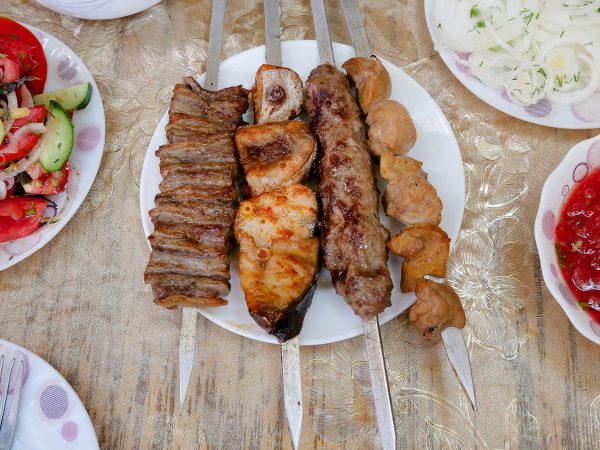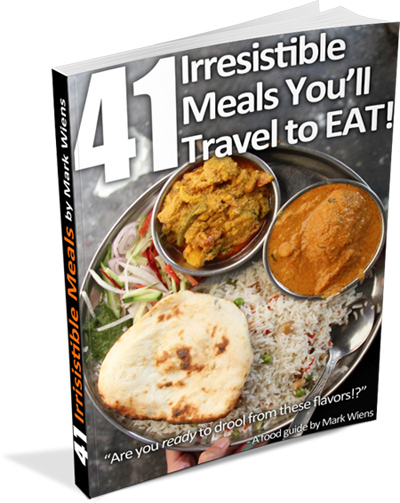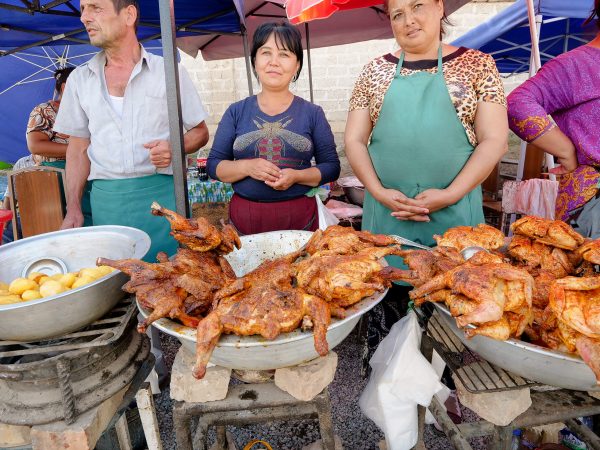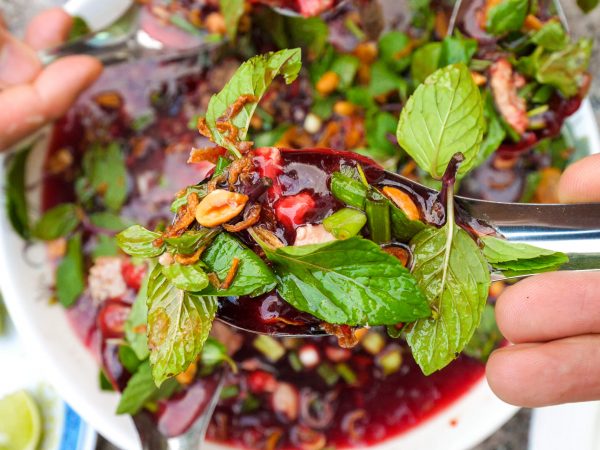
If you love Korean food, you don’t want to miss eating your way through Gwangjang Market in Seoul.
It’s one of the ultimate places to experience traditional Korean street food and culture all under one delicious roof.
In this Gwangjang Market blog post I’m going to share with you all about one of the most mouthwatering Korean food experiences to have in Seoul.

Gwangjang Market
First established in 1905, Gwangjang Market is known to be the oldest continually functioning market in all of South Korea (source).
And it’s one of those places that has not only withstood the test of time, but it’s passed through many generations, and I would imagine that it looks virtually the same as it did fifty years ago.

Although Gwangjang Market has been written about in everywhere from Lonely Planet to Munchies, what I also like so much about it is that the market still remains authentic and retains its Korean cultural heritage, style, and charm.
This is a place in Seoul where you’ll find both tourists and Koreans, all enjoying the same delicious food.

There are a couple sections of the market, and when you’re walking around you’ll come across stalls selling clothes, fresh vegetables, and some random other market goods.
But the main section of the market is dedicated to prepared food, and it’s set up sort of like an indoor street food court, kind of like a food warehouse. It’s an amazing atmosphere.
Also, check out my Seoul Travel Guide here.

Korean Street Food
Gwangjang Market is an overwhelming place of gastronomic beauty, there are mounds of food and hungry people eating in every direction.
When it comes to the Korean street food available at the market, after walking around for a little while, you’ll notice there are a few different types of stalls that sell a similar assortment of dishes.
Eventually everything will look so good, and you’ll be faced with the paradox of choice (there are just too many good things to choose from), and so you’ll just have to sit down at the nearest stall and start eating.
Get exclusive updates
Enter your email and I’ll send you the best travel food content.

Soondae (Sundae) – blood sausage
I’ll admit, they may be a little scary in appearance (and description of what they contain), but don’t let that stop you from ordering a plate of Korean soondae, blood sausage.
The Korean version of blood sausage is remarkably juicy and moist, partly because it contains a mixture of blood and a good amount of sticky and soft mung bean noodles or sticky rice.

When you order a plate of soondae, one of the big long sausages will be taken off the eternal steamer, and sliced into pieces, and arranged onto a plate.
It’s also typically served with a few slices of lung on the top as well, and additionally with some perilla leaves and chili salt to garnish.

On my most recent trip to Seoul, my wife and I sat down at a stall owned by a very kind lady, and she sliced up the soondae, wrapped it in a perilla leaf, and to my surprise, she fed me!
It was an amazing Korean food experience, being fed at Gwangjang Market.
What I love so much about Korean soondae is the spongy texture and the combination of the blood sausage with all the fresh leaves and herbs to go with it.

Mayak gimbap – rice rolls
Gimbap is among the essential list of Korean foods to eat, rice and a few pickled veggies packed into seaweed, rolled up and sliced into bite sized pieces.
Gwangjang Market is famous throughout Korea for vendors that sell Mayak Gimbap, which literally translate to narcotic rice rolls (seriously), and if you could only choose one thing to eat when you’re there, this is what I would recommend.
The reason they are called narcotic rice rolls is not because they contain any sort of narcotics (at least that I know of), but rather because they have extreme addictive properties.

At the market you’ll find stacks of the mini rice rolls piled high. Most of them contain a similar mixture of vegetables on the inside, wrapped up into mini sausage sized little rolls.
The part of the mayak gimbap that really makes them addictive, at least in my opinion, is the great amount of sesame seeds and sesame oil that’s brushed onto each rice roll, giving them a sensational, addictive taste that’s literally irresistible.
I’m going to let you decide how addictive they are… but let me just tell you, they aren’t joking when they compare them to narcotics.

Tteokbokki – rice rolls
Another one of the most common Korean street foods, and something you’ll find in abundance at the market is tteokbokki.
These sticky dense rice rolls are stewed in a thick red chili sauce and they are especially common for the younger generation of Koreans who seem to eat them at every chance.
Served hot and fresh, right out of the simmering pan, tteokbokki makes a pretty good snack, and it’s pretty hearty and filling as well. The same stalls that sell gimbap and soondae will typically also offer tteokbokki.

Fresh seafood
There’s a lane within Gwangjang Market where you can get all sorts of fresh seafood including hwareo hoe, Korean sliced raw fish similar to sashimi, an assortment of exquisitely fresh and raw seafood, and the famous live octopus.
I haven’t yet had a chance to try the seafood at the market, but it’s an option that you have. Prices are expensive but worth it (I’ll be sharing about my seafood and raw octopus eating experience soon).

Bindaetteok – mung bean pancake
Among all the delicious Korean food available, Gwangjang Market is particularly famous throughout Seoul for the mung bean pancakes known as bindaetteok.
There are some extremely famous stalls in the market, some good info here, but if you just walk around you’ll see dozens of stalls in the center of the market selling this attractive shallow oil fried delicacy.
I chose at random the first lady that smiled at me and my wife, and we were soon seated on a bench as she sliced up the pancake with a pair of scissors and dropped it on our bar counter table along with a side of sauce and a bowl of kimchi.

The bindaetteok was extra crispy on the outside and soft like mashed potatoes on the inside. The soy vinegar onion side sauce elevated each bite of mung bean pancake into an even further dimensions of deliciousness.
Eating bindaetteok is pretty greasy, but it’s well worth trying when you’re at Gwangjang market.
Dazed by the wonderful flavors, the overwhelming bounty of Korean street food, and the luscious culinary fumes, I stumbled out of the Gwangjang Market patting my stomach with extreme satisfaction.
Conclusion
I’ve visited Seoul a couple of times, and spending time at Gwangjang Market is a place that never gets old.
From the abundance of traditional Korean street foods to sample, to the action and energy of all the people that scurry through the narrow food packed lanes, it’s a truly fantastic place to discover in Seoul.
There are lots of things to do when you’re in Seoul, but if you’re a food lover Gwangjang Market should be at the top of your list.
When you go, make sure you stop at multiple food stalls, and whatever you see that looks delicious, try it.
Gwangjang Market
Opening hours: Most of the market opening hours are from 8:30 am – 6 pm daily, but some restaurants open longer and some places are closed on Sunday. Overall, it’s a great day market on any day of the week.
Address: 88 Changgyeonggung-ro, Jongno-gu, Seoul
How to get there: It’s easy to get to the market by taking the Metro to Jongno-5 station and take either Exit 9 or 8 which will lead you right to the entrance of the market.
Prices: Seoul is not the cheapest city, even when it comes to eating street food you’ll pay $2 – $5 per plate. You could easily spend around $10 – $20 per person eating in this market.
Get exclusive updates
Enter your email and I'll send you the best travel food content.



